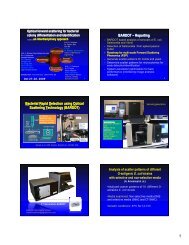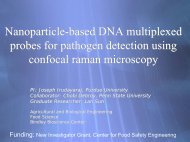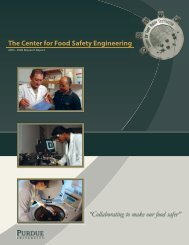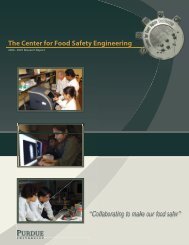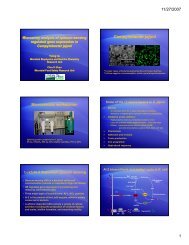Stanciu and AndreescuPortable biosensor <strong>for</strong> rapid and ultra-sensitive identificationof organophoshorous foodborne contaminantsInvestigators: Lia Stanciu (Department of Materials <strong>Engineering</strong>), Silvana Andreescu (Clarkson University)Project RationaleThe overall goal of this project was to advance the fi eld ofpesticide detection in food by developing ultra-sensitivebiosensors based on immobilized acetylcholinesterase (AChE).Over the past decades, AChE biosensors have emerged as apromising technique <strong>for</strong> food quality control. The developmentof these biosensors could complement or replace classicalanalytical methods by simplifying or eliminating samplepreparation and making identifi cation of chemical foodbornecontaminants easier and faster, with signifi cant decreases inanalysis time and cost.Project Objectives• Establish the optimum parameters <strong>for</strong> the immobilizationof AChE and the need and feasibility of using anoxidation strategy <strong>for</strong> phosphorothionates.• Fabricate and characterize the AChE biosensorby immobilizing the enzyme onto the surfaceof single-use screen-printing electrodes (SPE).Study enzyme stability and leaching.• Detect pesticides. Obtain calibration plots of theinhibitory degree upon application of variousconcentrations of pesticides. Determine thedetection limit (DL), response time (RT), and linearconcentration range (LCR) <strong>for</strong> selected pesticides.• Assemble and test the biosensor prototype <strong>for</strong> the analysisof pesticides in food samples. Evaluate the matrix effectsand establish whether an extraction step is needed.biosensors with enhanced characteristics. We are the fi rstresearchers to use this direct binding of enzymes onto Ni-NPs<strong>for</strong> this purpose. This accomplishment is important becausesite-specifi c orientation of enzymes onto electrode surfaceshas numerous advantages over classical procedures. It ishighly sensitive, avoids con<strong>for</strong>mational changes, decreasessensor costs (due to a lower enzyme requirement), and entailsa simple single fabrication step. This method has the potentialto become a robust, commercially viable system.Alternatively, the procedure combining sol-gel technology withscreen-printing protocols is also potentially useful <strong>for</strong> biosensorfabrication. Moreover, the sol-gel method is a versatile andeffi cient technique <strong>for</strong> conserving enzyme activity in organicsolvents. We expect that this matrix will enable functionality ofthe enzyme in the presence of organic solvents, if this mediumis necessary to extract the pesticides from the food matrix.Project HighlightsWe have made signifi cant progress toward establishingthe optimum parameters <strong>for</strong> enzyme immobilization usingtwo matrices (sol-gel and Ni-nanoparticles)) that enablepreservation of enzymatic activity. The procedure involvingattachment via affi nity binding to Ni-nanoparticles is new andhighly innovative and can be used to fabricate a new class of16<strong>Center</strong> <strong>for</strong> <strong>Food</strong> <strong>Safety</strong> <strong>Engineering</strong>“The development of these biosensors could complement or replace classicalanalytical methods by simplifying or eliminating sample preparation and makingidentifi cation of chemical foodborne contaminants easier and faster.”
Scientific Publications and PresentationsPeer Reviewed Journal Publications (2007-2008)• Bae, E., Banada, P.P., Huff, K., Bhunia, A.K., Robinson,J.P., Hirleman, E.D. Analysis of time-resolved scatteringfrom macroscale bacterial colonies. Journal ofBiomedical Optics. 2008. v. 13 (1). p. 014010.• Banerjee, P., Lenz, D., Robinson, J.P., Rickus, J.L., Bhunia,A.K. A novel and simple cell-based detection systemwith collagen-encapsulated B-lymphocyte cell line as abiosensor <strong>for</strong> rapid detection of pathogens and toxins.Laboratory Investigation. 2008. v. 88. p. 196-206.• Bao, N., Jagadeesan, B., Bhunia, A.K., Yao, Y., Lu,C. Quantifi cation of bacterial cells based onautofl uorescence on a microfluidic plat<strong>for</strong>m. Journalof Chromatography. 2008. v. 1181. p. 153-158.• Bao, N., Lu, C. A microfluidic device <strong>for</strong> physicaltrapping and electrical lysis of bacterial cells. AppliedPhysics Letters. 2008. v. 92. p. 214103.• Bao, N., Wang, J., Lu, C. Recent advances in electricanalysis of cells in microfluidic systems. Analytical andBioanalytical Chemistry. 2008. v. 391. p. 933-942.• Bhattacharya, S., Salamat, S., Morisette, D., Banada, P.,Akin, D., Liu, Y-S., Bhunia, A. K., Ladisch, M., Bashir, R.PCR based-detection in a micro-fabricated plat<strong>for</strong>m.Lab on a Chip. 2008. v. 8. p. 1130-1136.• Bhattacharya, S., Jang, J., Yang, L., Akin, D., Bashir, R.BioMEMS and nanotechnology based approaches <strong>for</strong> rapiddetection of biological entities. Journal of Rapid Methodsand Automation in Microbiology. 2007. v. 15. p. 1-32.• Bhunia, A.K. Biosensors and bio-based methods <strong>for</strong> theseparation and detection of foodborne pathogens. Advancesin <strong>Food</strong> and Nutrition Research. 2008. v. 54. p. 1-44.• Burgula, Y., Khali, D., Kim, S., Cousin, M.A., Gore, J. P.,Reuhs, B.L., Mauer, L.J. Review of mid-IR Fouriertrans<strong>for</strong>minfrared (FT-IR) spectroscopy applications<strong>for</strong> bacterial detection. Journal of Rapid Methods andAutomation in Microbiology. 2007. v. 15. p. 146-175.• Chapple, C., Ladisch, M., Meilan, R. LooseningLignin’s grip on biofuel production. NatureBiotechnology. 2007. v. 25 (7). p. 746-748.• Jedlica, S.S., Little, K.M., Nivens, D.E., Zemlyanov, D., Rickus,J.L. Peptide ormosils as cellular substrates. Journal ofMaterials Chemistry. 2007. v. 17. p. 5058-5067.• Kim, H., Bhunia, A.K. SEL, a selective enrichment broth <strong>for</strong>simultaneous growth of Salmonella enterica, Escherichiacoli O157:H7, and Listeria monocytogenes. Applied andEnvironmental Microbiology. 2008. v. 74 (15). p. 4853-4866.• Kim, G., Morgan, M.T., Ess, D.R., Hahm, B.K., Kothapalli, A.,Bhunia, A.K. An automated fiber-optic biosensor based bindinginhibition assay <strong>for</strong> the detection of Listeria monocytogenes.<strong>Food</strong> Science and Biotechnology. 2007. v. 16(3). p. 337-342.• Kim, Y., Hendrickson, R., Mosier, N. S., Ladisch, M. R., Bals,B., Balan, V., Dale, B.E. Enzyme hydrolysis and ethanolfermentation of liquid hot water and afex pretreateddistillers’ grains at high-solids loadings. BioresourceTechnology. 2008. v. 99(12). p. 5206-5215.• Kim, Y., Mosier, N. S., Hendrickson, R., Ezeji, T., Blaschek, H., Dien,B., Cotta, M., Dale, B., Ladisch M. R. Composition of corn drygrindethanol by-products: DDGS, 3 wet cake, and thin stillage.Bioresource Technology. 2008. v. 99(12). p. 5165-5176.• Kim, Y., Mosier, N., Ladisch, M. R. Process simulationof modified dry grind ethanol plant with recycle ofpretreated and enzymatically hydrolyzed distillers’ grains.Bioresource Technology. 2008. v. 99(12). p. 5177-5192.• Ladisch, M., Dale, B., Tyner, W., Mosier, N.S., Kim, Y., Cotta, M.,Dien, B.S., Blaschek, H., Laurenas, E., Shanks, B., Verkade, J.,Schell, C., Petersen, G. Cellulose conversion in dry grind ethanolplants. Bioresource Technology. 2008. v. 99(12). p. 5157-5159.• Ladisch, M. R., Dale, D. Distillers grains: On thepathway to cellulose conversion. BioresourceTechnology. 2008. v. 99(12) p. 5155-5156.• Lathrop, A.L., Banada, P.P., Bhunia, A.K. Differentialexpression of InlB and ActA in Listeria monocytogenesin selective and nonselective enrichment broths. Journalof Applied Microbiology. 2008. v. 104. p. 627-639.• Liu, Y-S., Banada, P.P., Bhattacharya, S., Bhunia, A.K.,Bashir, R. Electrical characterization of DNA moleculesin solution using impedance measurements. AppliedPhysics Letters. 2008. v. 92. p. 143902.• Liu, Y-S., Walter, T. M., Chang, W-J., Lim, K-S., Yang, L.,Lee, S-W., Aronson, A., Bashir, R. Electrical detectionof germination of model Bacillus Anthracis spores inmicrofluidic biochips. Lab Chip. 2007. v. 7. p. 603-610.• Stewart, P.S., Franklin, M.J. Physiological heterogeneity inbiofilms. Nature Reviews Microbiology. 2008. v. 6 p.199-210.• Vermerris, W., Saballos, A., Ejeta, G., Mosier, N. S., Ladisch,M. R., Carpita, N. C. Molecular breeding to enhance ethanolproduction from corn and sorghum stover. Crop ScienceSociety of America. 2007. v. 47(S3). p. S142-S153.• Wang, C., Irudayaraj, J. Gold nanorod probesdetects multiple pathogens. Small – aNanotechnology Journal. 2008. (In Press).• Ximenes, E. A., Dien, B. S., Ladisch, M. R., Mosier, N.,Cotta, M. A., Li, X. L. Enzyme production by industriallyrelevant fungi cultured on feed co-product from corndry grind ethanol plants. Applied Biochemistry andBiotechnology. 2007. v. 136-140 (1-12). p. 171-183.• Yang, L., Banda, P.P., Bhunia, A.K., Bashir, R. Effects ofdielectrophoresis on growth, viability, and immunoreactivityof Listeria monocytogenes. Journal ofBiological <strong>Engineering</strong>. (2008) v. 2(6). p.“This year, the CFSE team published 31 peer-reviewed researchpublications and presented 18 talks at national science meetings.”17<strong>Center</strong> <strong>for</strong> <strong>Food</strong> <strong>Safety</strong> <strong>Engineering</strong>






